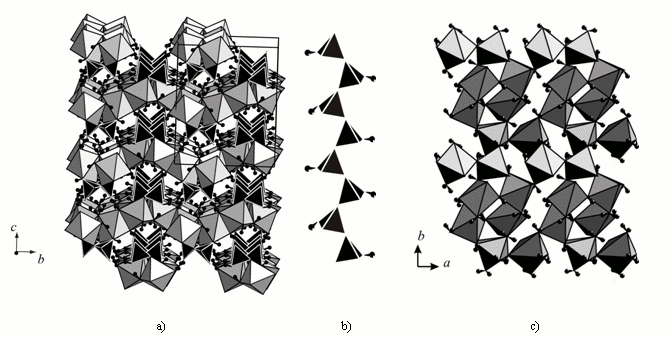2010
| News | Registration | Abstracts | Accommodation | Excursions | Deadlines | Organizing committee |
| Second circular | Participants | Abstract submission | Travel | Program | Seminar History | Contact us |
| Новости |
| Первый циркуляр |
| Второй циркуляр |
| Регистрация |
| Оформление тезисов |
| Тезисы |
| Программа |
| Участники |
| Размещение |
| Экскурсии |
| Проезд |
| Важные даты |
| Оргкомитет |
| Обратная связь |
Crystal structure of yegorovite, the first natural sodium silicate with tetrahedral Si,O chains
Zubkova N.V., Pekov I.V., Pushcharovsky D.Yu.
Geology Dept., Moscow State University, Moscow, Russia
nata_zubkova@rambler.ru
To recent time, only 11 natural silicates with only alkali cations were known. Na is a species-defining element in all these minerals with K added in megacyclite and Li in silinaite. In 2008 the IMA Commission on New Minerals, Nomenclature, and Classification approved the new mineral yegorovite, Na4[Si4O8(OH)4]•7H2O. It was named in memory of the outstanding Russian crystallographer and crystal chemist Yurii Kvaldievich Yegorov-Tismenko (1938–2007) in recognition of his important contribution to the crystal chemistry of natural and synthetic alkali-bearing silicates. Yegorovite was found in late hydrothermal, low-temperature assemblage in the Palitra peralkaline pegmatite at Mt. Kedykverpakhk, Lovozero alkaline complex, Kola Peninsula, Russia. Yegorovite forms coarse, usually divergent prismatic or lamellar crystals typically forming polysynthetic twins and parallel intergrowths. Its empirical formula is: Na3.98Si4.01O8.02(OH)3.98•7.205H2O; the idealized formula is: Na4[Si4O8(OH)4]•7H2O (Pekov et al., 2009).
A crystal of yegorovite with dimensions 0.02 x 0.05 x 0.44 mm3 was used for structure determination at room temperature (diffractometer Xcalibur S equipped by CCD detector, MoKa-radiation, l = 0.71073 Å; absorption correction applied by CrysAlis programme according to the shape of the crystal). Monoclinic unit cell with a = 9.8744(4), b = 12.3981(5), c = 14.8973(7) Ǻ, β = 104.675(5)о, V = 1764.29(13) Ǻ3 was revealed. Space group P21/c was determined on the basis of the systematic absences. The structure was solved by direct methods and refined anisotropically using SHELX (Sheldrick 1997) to R = 0.0745 for 1977 unique reflections with I>2s(I) (all hydrogen atoms were localized and refined isotropically).
Yegorovite is a representative of a new structure type, its crystal structure is unique. It is the first natural sodium silicate with simple (single) chains of SiO4 tetrahedra in the structure. No natural and synthetic compounds structurally related to yegorovite are known so far. The crystal structure of yegorovite (Fig. 1a) contains the zigzag single chains [Si4O8(OH)4]¥ with a period of four Si tetrahedra (Fig. 1b) elongated along the a axis. The degree of chain extension is fs = 0.914. According to F. Liebau, the unbranched tetrahedral silicon–oxygen chain in the structure of yegorovite might be presented in general as {uB11¥}[4Si4O8(OH)4]4-. One of two non-bridging vertices of each Si tetrahedron is represented by (OH) group. Four crystallographically nonequivalent Na atoms occupy six-fold polyhedra of two types: [NaO(OH)2(H2O)3] и [NaO(OH)(H2O)4]. These Na polyhedra are connected via common vertices and edges and form corrugated layers lying in the ab plane (Fig. 1c). The layer consists of 3-, 4-, 5- and 8-membered rings of Na-polyhedra. Each layer is adjoined from both sides by silicate chains forming heteropolyhedral Si,Na layers which are linked to each other by a system of hydrogen bonds.

Fig. 1. The crystal structure of yegorovite (a); Si chain (b) and Na layer (c) in the structure of yegorovite. Na octahedra are gray, Si tetrahedra are black. H atoms are small black circles.
Thus the investigation of yegorovite allowed to fill a substantial gap in the list of silicate motives in the structures of purely alkaline natural silicates: now there are known the framework (grumantite, Na[Si2O4(OH)]·H2O), various types of layers (natrosilite, Na2[Si2O5], silinaite, NaLi[Si2O5]·2H2O, makatite, Na2[Si4O8(OH)2]·4H2O, kanemite, NaH[Si2O4(OH)2]·2H2O, and magadiite, Na[Si7O13(OH)3]·4H2O), ribbons (revdite, Na16[Si4O6(OH)5]2[Si8O15(OH)6](OH)10·28H2O), rings (megacyclite, KNa8[Si9O18(OH)9]·19H2O), single chains (yegorovite, Na4[Si4O8(OH)4]•7H2O) and isolated tetrahedra (chesnokovite, Na2[SiO2(OH)2]·8H2O). The crystal structures of kenyaite, Na2Si22O41(OH)8·6H2O, and ertixiite, Na2Si4O9, are still unknown.
This study was financially supported by RFBR: grants 09-05-00143-а and 08-05-00077-a and grants of President of Russian Federation nos. MK-320.2010.5, NSh-4034.2010.5 and NSh-3848.2010.5.
References:
Pekov I.V., Zubkova N.V., Chukanov N.V., Zadov A.E., Grishin V.G., Pushcharovsky D.Yu. Yegorovite, Na4[Si4O8(OH)4]•7H2O, a new mineral from the Lovozero alkaline massif, Kola Peninsula, Russia. // Zapiski RMO. 2009. Vol. 138. No. 3. P. 82-89 (in Russian).
Sheldrick G.M. SHELX-97: Program for the solution and refinement of crystal structures. Siemens Energy and Automation, Madison, WI. 1997.